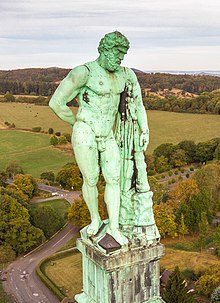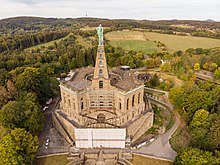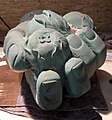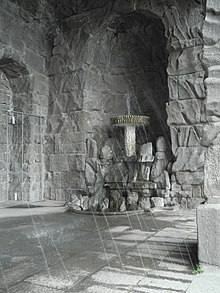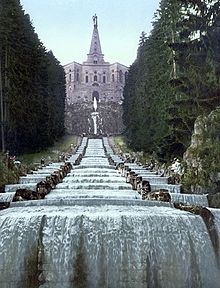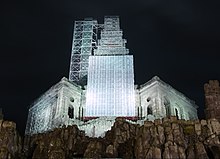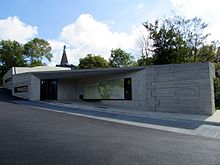Hercules (Kassel)
The Hercules is a copper statue of the Greek demigod Heracles ( Latin Hercules , Germanized Hercules ) in the Bergpark Wilhelmshöhe in Kassel ( Northern Hesse , Germany ). The statue, which is considered a landmark of the city of Kassel, is located at the top of a pyramid that stands on the octagon , the giant castle . Today the name "Hercules" stands not only for the statue, but also for the entire structure, which also forms the starting point for the summer water features in the mountain park. The octagon and the Hercules go back to different construction phases. Since June 23, 2013, the Hercules - as part of the Wilhelmshöhe Mountain Park - has been on the UNESCO World Heritage List as an example of absolutist architecture .
The building is in the Bad Wilhelmshöhe district , on the eastern ridge of the Habichtswald . It was built in a light, artificially formed hollow of the Karlsberg ( 526.2 m above sea level ) on the westernmost and at the same time highest point ( 515 m ) of the line of sight Schloss Wilhelmshöhe - Herkules.
history
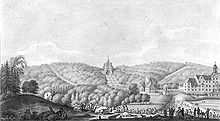
The castle-like Hercules was created between 1701 and 1717 based on designs by the Italian Giovanni Francesco Guerniero . The entire complex, including the cascades in front of the Hercules, bears the name Karlsberg after the builder, Landgrave Karl von Hessen-Kassel , and under this term is a baroque aspect both spatially and historically and a western end of the Wilhelmshöhe mountain park.
As early as 1696, under Landgrave Karl, construction began on a central axis of the then modest park. At the same time, on the eastern ridge of the Habichtswald, about 500 m south-southeast of today's Hercules and a few meters below the summit of Hüttenberg ( 555 m ), the first parts of the building were built for a giant castle - called Little Hercules or Old Winter Chest. However, it was decided not to view the Hüttenberg as the future focal point of the park. The construction site was given up and the work there was stopped. On the ruin, which has been overgrown by the forest for a long time, there are still some remains of walls and foundations about 7 m high.
Landgrave Karl only met Giovanni Francesco Guerniero in Italy in 1699. Construction of the giant baroque castle began in 1701, and the Hercules statue was erected on its roof pyramid on November 30, 1717, completing the building. Due to the inhospitable weather typical of Kassel in November, the “birthday” of the building will be celebrated on July 17th, based on the year of completion.
The design developed jointly by the Landgrave and the architect was modified several times, so the pyramid with the Hercules statue is attributed to a later idea of the ruler. Engravings made in 1706 show that much more extensive construction work was planned than was ultimately carried out. Guerniero wanted the upstream cascades to lead down the entire mountain slope to today's Wilhelmshöhe Castle. Only about a quarter of the length was realized, which was probably less due to the will of the landgrave than to his limited financial possibilities. The remaining space between the cascades and the castle was finally filled 70 years later - through basically completely contrary plans - and today forms the core of the English landscape garden - the Bergpark Wilhelmshöhe .
On August 31, 2011, Minister of Culture Eva Kühne-Hörmann signed the application to propose the Bergpark Wilhelmshöhe with the Hercules as a UNESCO World Heritage Site . In January 2012, the State of Hesse submitted the application for the entry of the "Water features and Hercules in Bergpark Wilhelmshöhe" to the Permanent Representation of the Federal Republic of Germany to UNESCO in Paris. This forwarded the application to the UNESCO World Heritage Center, which made a positive decision on the application in June 2013.
Hercules statue
The copper statue of Hercules stands on top of a stone pyramid that was erected on the east side of the ceiling of the octagon.
The square pyramid, which stands on a square base, was created in 1714/1715 and is 26 m high. The Hercules statue on its top consists of a wrought-iron skeleton, which is covered with 2-3 mm thick, hand-driven sheets of copper sheet. The figure has a height of 8.30 m and stands on a plinth that is 3.00 m high. The total weight of the 11.30 m high statue is 7.8 t. The wrought iron inner construction accounts for 5.3 t and the copper skin including its inner strips made of iron / steel is 2.5 t.
The copper statue of Hercules was created between 1713 and 1717 as the work of the goldsmith Johann Jacob Anthoni from Augsburg . The load-bearing inner framework was made by the Kassel construction blacksmith Johann Balthasar Klocke. The raw copper came from the Richelsdorf copper ore mine in the Richelsdorf mountains . The four half-shells that make up the head were already formed there in a hammer mill. The remaining raw copper was delivered to the Kassel brass yard in the form of bars . There, these bars were driven into copper sheets 3 mm thick with the help of water-powered tail hammers , and these sheets were preformed. The preformed sheets were up to one square meter in size. These were the basis for the subsequent, complex driving work by Anthoni. The formation of details (head, hands with apples), which are therefore composed of much smaller individual sheets, was complicated. The finished sheets were interlocked, soldered and secured with small rivets at their edges. Almost invisible connections were created. In order to enable the transport from the workshop to the building, 21 segments were prefabricated from which the 8.30 m high Hercules figure is composed. The riveted connection between these segments is visible and reversible - partial segments of the figure can be removed. The authorship of Anthonis only became known in 1900 when a copper plaque made by him in 1717 was discovered under the skull of the Hercules figure.
In terms of art history, the statue belongs to the type of Hercules Farnese , the resting Heracles reflecting on his deeds. The hero is in a contemplative position, bent slightly forward and with his upper body turned to the left. The typical attributes are the vertically standing club on a rock, which is hung with the skin of the Nemean lion (1st act) and serves as a support for the figure under the left armpit. His right hand lies on his back and holds the apples of the Hesperides (11th act). They stand for love, fertility and eternal youth, the lion skin z. B. for force. Hercules was an ideal of rulers, especially in the 16th and early 17th centuries, which replaced Apollo in the Enlightenment and Classical periods. Both ideals, which (also) the Landgraves of Hessen-Kassel claimed for themselves in different times, are exemplarily present in the Bergpark, with the Hercules statue and the Kassel Apollon in Wilhelmshöhe Palace.
| Dimensions of the statue: | |
|---|---|
| Hercules figure | 8.30 meters |
| base | 3.00 meters |
| Head height | 1.45 meters |
| Shoulder width | 2.70 meters |
| Chest circumference | 5.50 meters |
| Foot length | 1.20 meters |
| Length of the club | 3.50 meters |
| Diameter of the apples of the Hesperides | 0.20 meters |
Octagon
The octagonal building, also a giant castle , is an open, unglazed structure with a diameter of 70 m and a height of 33 m.
The three-storey structure of the octagon goes up from naturally stacked rock as a supporting foundation , into geometrically arranged architecture . On its outer sides, outside stairs lead to the upper floors. The lower floor was provided with four rocky round arches, through the easternmost of which one can get into the building. Inside there is an octagonal courtyard with a water reservoir embedded in the floor. The much smaller round arches on the second floor have already been executed in more geometric shapes. The huge viewing platform, the Belvedere, rests on the top floor, where brick struts and round arches are made of smooth stone facades. Four risalites are attached to the octagonal Belvedere , which give the overall structure its characteristic silhouette.
The octagon of Hercules can be understood in the context of the water features as a gigantic, enlarged spring structure. Even today, the building is the starting point for the baroque water axis to the east, which was originally planned to be much longer.
Water puzzle grotto and artichoke basin
Below the octagon to the east is the horseshoe-shaped water puzzle grotto. The artichoke basin is located in the courtyard. Inside the Vexierwassergrotte there are figures that quote mythological motifs. They are renewals of the historical, baroque works. The central figure was originally one of the Cyclops Polyphemus and was replaced in the 19th century.
- in the central wall niche: Pan ,
- to the left of it, in the southern niche, Eris as the female allegory of envy,
- on the right, in the northern niche, Chronos symbolizing time and death.
There are also two side wall niches in which there are round basins with fountain tables.
Hidden behind the figure of Polyphemus or Pan was a water-powered barrel organ , the so-called water organ , whose music seemed to come from the shepherd's flute. The sounds were intended to attract visitors, who were then sprayed wet in the grotto with water from small nozzles embedded in the floor - the so-called conundrum. The water of the conundrum is not constantly in use, but is intended to surprise and tease visitors. The water organ was restored in 2014 and has been exhibited in Wilhelmshöhe Palace since 2017. A true-to-original replica made in 2017 is to be put back in its old location from 2021 after the restoration work on the octagon has been completed. The configuring water jets are back in operation; it and the fountain tables can be started for a short period of time using a coin-operated machine in the grotto.
The name of the basin in front of the grotto is derived from the tufa formation in its center, which represents an artichoke fruit. During the water games, an approx. 10 m high central fountain rises from its center, which is surrounded by approx. 8 m high side fountains.
The water conundrum is bordered by the curved cascades on both sides . These initially run parallel to the accompanying stairs and then bend to the plateau with grotto and basin.
Giant head plateau
Below the Vexierwassergrotto with the artichoke basin is the giant head plateau to the east. The head of the giant Enceladus , whose body is buried under the boulders, can be seen in its basin under a steep rock wall . In the niches on both sides of the rock there are other mythological figures:
During the water games, a fountain rises from the “mouth” of the lying stone giant. At the same time, the horns of the figures can be heard, driven by the air carried away by the water in a so-called "Camera Aeolia".
The plateau is bordered by the semicircular cascades on both sides .
Cascades
The cascades and basins upstream of the slope towards the east are supplied with water for the water features from the Sichelbach basin . The fire extinguishing pond and the unlucky pond , both north of the octagon, serve as intermediate storage above ground.
The total length of the water system between the Vexierwassergrotte and the Neptune basin is around 320 m; including the octagon this is about 400 m. Between the two uppermost water outlets, above the Vexierwassergrotto, and the Neptune basin, at the lowest end of the cascades, there is a difference in altitude of 105 m.
The actual cascades, which overcome an altitude difference of around 80 meters, lie between the Giant Head Plateau and the Neptune Basin. As far as the Riesenkopf plateau, the water is partly above and partly underground, partly via small cascades on the side, now it follows the central large cascades down the slope. These are a 250 meter long stone construction that represents a gigantic enlarged water staircase. The middle part of the 9 m wide cascades, the 5.50 m wide main cascades, are accompanied on both sides by 1.75 m wide and slightly higher level secondary cascades, with the human steps on both sides, the large cascades are 12 meters wide.
235 m³ of water can be used for the large cascades. The cascades are subdivided by three intermediate water basins. Their function in the context of the water features consists in a "choreography" of the water flow: the water flowing down over the steps is stopped for a few seconds, and shortly afterwards - out of the basin - it continues its way over the gigantic stone steps. When the system was built, there were also fountains in these intermediate basins.
At the bottom of the Grand Cascade, the water plunges 6 m deep into the sea god Neptune consecrated Neptune Pool . His statue is enthroned in a shell in Neptune's grotto below the Great Cascades.
Figure of Neptune (2014)
The cascade structure is accompanied on both sides by steps, which were built to the usual human standards and give visitors access to the structure or to the water features (539 steps on the right; 535 steps on the left). There are a total of 885 steps from the Neptune basin to the statue of Hercules.
Starting point for the water games in the park
The first trick fountains on the Hercules, formerly called " Water Arts", took place as early as 1714. This was before the final completion of the entire complex when the statue of Hercules was erected on the roof pyramid of the octagon.
The cascades and basins in front of the octagon to the east down the slope form the upper, baroque part of the water features in the Bergpark Wilhelmshöhe . This oldest part, created under Landgrave Karl , is followed downhill by the stations of the later, romantic area, created under Landgrave Wilhelm IX with:
- Steinhöfer waterfall
- Waterfall at the Devil's Bridge
- aqueduct
- Big blow dryer
Building material and erosion
Virtually all of the structure - octagon and cascades - consists of lapilli - tuff , the basalt Habichtswald which was obtained in nearby quarries. The soft material had the advantage of being relatively easy to work with, but it weathers relatively quickly and has been a problem in maintaining the structure for 300 years. The main problem here is frost erosion: the porous tufa absorbs rainwater on the surface. These moist edge areas flake off in layers in frost. Another problem is the sheer mass of the structure and the different subsurface. The structure is pushed apart by its own weight. While the western part rests on a stable basalt base, the east side facing the city stands on tuff and clay rubble. Until the anchoring bore was carried out, the eastern section and the upstream grottoes threatened to slide down the Karlsberg. Some halls and the entire south wing are closed to visitors due to the risk of collapse or falling rocks.
Redevelopment
Urgent and extensive renovation work to preserve the structure has been taking place since autumn 2005. They are part of the state concept for the reorganization of the Hessen Kassel museum landscape and should be completed in 2011 according to the Hessian Ministry for Science and Culture. The cost of the renovation was originally estimated at 21 million euros, due to delays due to further previously unknown damage and rising construction costs, the ministry estimated the costs at around 30 million euros in May 2011.
As in 1900 and 1951, since 2006 the statue has also been renovated in connection with the renovation of the building; this was u. a. the head was dismantled and exhibited in Wilhelmshöhe Castle for some time at the end of 2006 . In August 2008 the head was put back on. From May 2011 the platform and pyramid should be open to visitors again. After this date was postponed to the end of August in June 2011, the reopening took place on September 4th. To date, 13.6 million euros of the renovation budget have been spent. The end of the renovation work was announced for 2013.
The renovation work on the cascades was completed in 2019; the interior of the octagon is still inaccessible.
Possibility of viewing
Even from the foot of Hercules , but especially from its large viewing platform , there is a wide view:
To the east, the view falls over the main axis of Bergpark Wilhelmshöhe with the cascades and Wilhelmshöhe Castle along Wilhelmshöher Allee in the direction of Kassel's city center, whereby almost the entire city area can be seen. The large canopy of the Kassel-Wilhelmshöhe station on the avenue cannot be overlooked . On the horizon from north to south the Reinhardswald , the Kaufunger Wald , the Hohe Meißner and the Söhre can be seen. Between the first two forests mentioned, the Gauss tower on the Hohe Hagen in the Dransfeld city forest can be made out, especially when it is illuminated by the sun, which is already quite deep in the west. To the northeast, past the Hohen Hagen, you can even see the Brocken in the Harz Mountains when the weather is clear , especially with prism binoculars . To the west, the view falls on the high elevations of the Habichtswald , for example over to the Essigberg with the Habichtswald telecommunications tower and to the northwest over to the Hohen Dörnberg . To the southwest you can see the Kellerwald , in which the towers on the desert garden and on the Hohen Lohr can be seen.
Hercules Visitor Center
The newly built Herkules visitor center was opened in 2011 about 200 m north-west of the Herkules . In particular, it provides information on the mountain park with water arts and Hercules, recognized as a UNESCO World Heritage Site .
Transport links and hiking
From 1903 to 1966 the Herkulesbahn transported people from Kassel up to the Herkules. Today buses run on KVG line 22 and, during the season, line 23 'to the turning loop at the end of the building. Individual vehicles can be used to drive to the large parking lot at the Herkules visitor center. The hiking trails Habichtswaldsteig , Herkulesweg , Kassel-Steig , Märchenlandweg and Studentpfad lead directly past the Hercules . Hercules and the surrounding park can be explored, which includes the Kassel water features.
Trivia
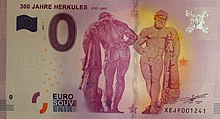
Hercules beer was brewed in the Losch brewery in Kassel, founded in 1861. The brewery was later renamed the Herkules Brewery. This was taken over by Binding in 1972 and closed in 1999.
On the occasion of the 300th anniversary in 2017, euro bills with a face value of zero euros were issued as souvenirs .
literature
- Giovanni Francesco Guerniero: Delineatio Montis. Cassel 1706.
- Facsimile: Leipzig 1988 (also Stuttgart 1988).
- Paul Heidelbach: The history of Wilhelmshöhe. Klinkhardt & Biermann, Leipzig 1909.
- Facsimile, Ed .: Dieter Carl, Vellmar 2005.
- Christiane Lukatis (Ed.): Hercules. Hero of virtue and ideal of rulers. The Hercules Monument in Kassel-Wilhelmshöhe. Eurasburg, 1997, ISBN 3-932353-06-4 .
- Thomas Ludwig: The Hercules in Kassel. 2004, ISBN 3-7954-1668-X .
Web links
- Herkules (official website), on museum-kassel.de
- The Hercules through the ages , report by Marie Eberhardt, from September 26, 2016, on hna.de.
- Water games in Bergpark Wilhelmshöhe , on kassel.de
Individual evidence
- ↑ Cheers in Kassel: Bergpark is a World Heritage Site ( memento from June 26, 2013 in the web archive archive.today ), from June 23, 2013, from hna.de
- ↑ Official city map (of Kassel), publisher : Magistrat der Stadt, Vermessungsamt, Kassel, 1995, scale 1: 20,000
- ↑ Kassel: Hercules should become a world cultural heritage ( memento from February 21, 2013 in the web archive archive.today ), August 31, 2011, accessed on September 3, 2011, from faz.net ( Hercules statue is explicitly mentioned, but what is is a misunderstanding, as the following step shows)
- ↑ Standing Conference of the Ministers of Culture of the Federal Republic of Germany (KMK): Fountains and Hercules in Bergpark Wilhelmshöhe nominated for World Heritage ( Memento from September 7, 2012 in the web archive archive.today ), press release from January 19, 2012, accessed on 26. February 2012, from kmk.org
- ↑ Unesco names Kassel Hercules a World Heritage Site , June 23, 2013, on spiegel.de
- ↑ Dimensions in paragraph according to Siegfried Hoß: World Heritage Bergparkpark Wilhelmshöhe. The water arts , park brochures MHK Volume 2, 2014, data and facts from the world heritage application , p. 105
- ^ Weights according to Franziska Franke and Astrid Schlegel: World Heritage Bergparkpark Wilhelmshöhe - Der Herkules , Park Brochures MHK Volume 4, 2017, Dimensions and Weights , p. 88
- ^ Paragraph on production according to Franziska Franke and Astrid Schlegel: World Heritage Bergparkpark Wilhelmshöhe - Der Herkules , Park Brochures MHK Volume 4, 2017, pp. 39–45
- ↑ Data based on Franziska Franke and Astrid Schlegel: World Heritage Bergparkpark Wilhelmshöhe - Der Herkules , Park Brochures MHK Volume 4, 2017, Dimensions and Weights , p. 88
- ↑ Dimensions in a sentence based on Siegfried Hoß: World Heritage Bergparkpark Wilhelmshöhe. The water arts , park brochures MHK Volume 2, 2014, data and facts from the world heritage application , p. 105
- ↑ cf. Siegfried Hoß: World Heritage Bergparkpark Wilhelmshöhe. The water arts , park brochures MHK Volume 2, 2014, p. 25
- ↑ Allocation of the figures and paragraph to the story according to Franziska Franke and Astrid Schlegel: World Heritage Bergparkpark Wilhelmshöhe - Der Herkules , Park Brochures MHK Volume 4, 2017, pp. 57–58
- ^ Fontänenhöhen according to Siegfried Hoß: World Heritage Bergparkpark Wilhelmshöhe. The water arts , park brochures MHK Volume 2, 2014, p. 27
- ↑ Allocation of the figures according to Horst Becker: 1.3 The baroque complex in Park Wilhelmshöhe Kassel Parkpflegewerk , 2007, pp. 46–47. After Siegfried Hoß: World Heritage Bergparkpark Wilhelmshöhe. The water arts , park brochures MHK Volume 2, 2014, p. 41, on the other hand, "[...] Zentauer and Faun on the side of the giant head basin [...]"
- ↑ Height difference according to Horst Becker and Michael Karkosch: 2.9 Garden architecture in Park Wilhelmshöhe Kassel Parkpflegewerk , 2007, p. 305
- ↑ Breiten according to Horst Becker and Michael Karkosch: 2.9 Garden architecture in Park Wilhelmshöhe Kassel Parkpflegewerk , 2007, p. 306
- ^ Volume of water according to Siegfried Hoß: World Heritage Bergparkpark Wilhelmshöhe. The water arts , park brochures MHK Volume 2, 2014, p. 46
- ↑ this lead construction is said to have been dismantled during the Seven Years' War, cf. Siegfried Hoß: World Heritage Bergparkpark Wilhelmshöhe. The water arts , park brochures MHK Volume 2, 2014, p. 47
- ↑ a b Renovation in Kassel - near Herkules' foot veins , Frankfurter Allgemeine Zeitung of July 4, 2007
- ↑ Sanierung des Herkules ( Memento from August 1, 2012 in the web archive archive.today ), Hessian Ministry for Science and Culture, from hessen.de
- ↑ Hercules renovation is getting more and more expensive - construction work is delayed , HNA dated May 17, 2011
- ↑ a b c Kassel has its Herkules again , accessed on September 5, 2011, on fnp.de.
- ↑ a b Hercules open again in May , Hessische / Niedersächsische Allgemeine, January 26, 2011, accessed on February 11, 2011, on hna.de
- ↑ Thomas Siemon: 81 steps to Hercules: pyramid can be walked on again soon , from June 22, 2011, accessed on August 26, 2011, on hna.de.
- ↑ New visitor center opened at Herkules / investment of 4.6 million euros ( memento from August 1, 2012 in the web archive archive.today ), press release from the Hessian Ministry for Science and Culture from June 12, 2011, from hmwk.hessen.de
Coordinates: 51 ° 18 ′ 59 ″ N , 9 ° 23 ′ 34 ″ E
